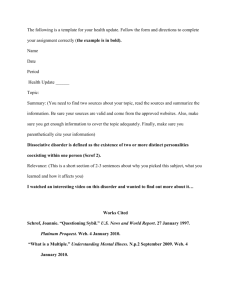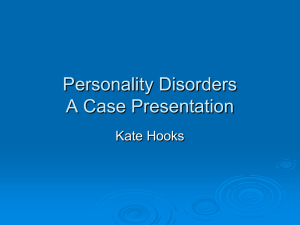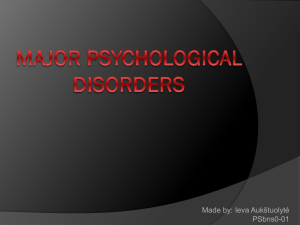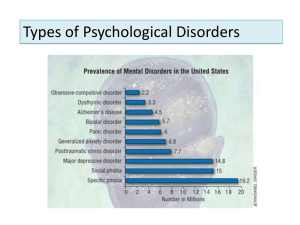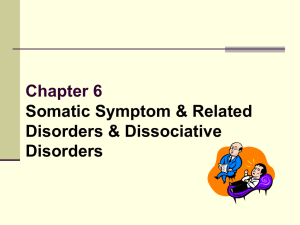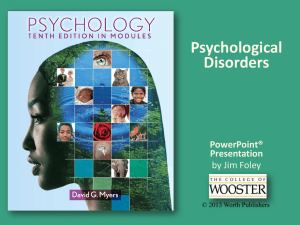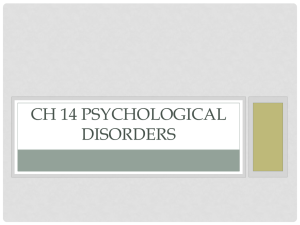Dissociative Disorder
advertisement
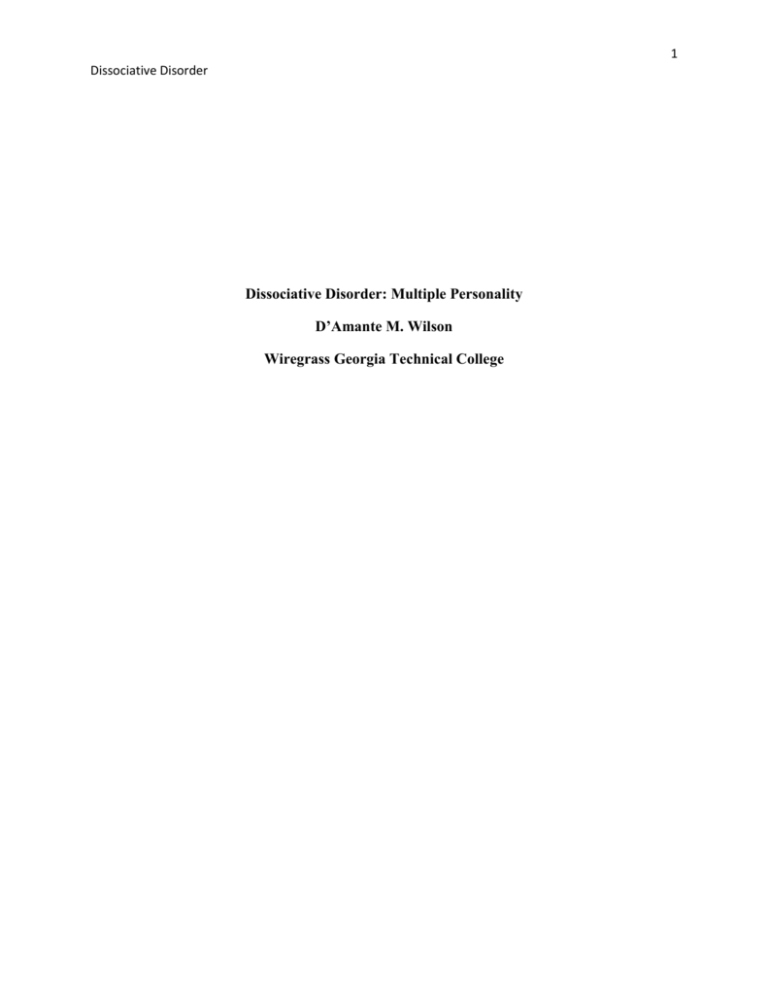
1 Dissociative Disorder Dissociative Disorder: Multiple Personality D’Amante M. Wilson Wiregrass Georgia Technical College 2 Dissociative Disorder Abstract Dissociative Identity Disorder is a disorder that causes a person to lose periods of consciousness. The loss of consciousness and, often, memory is caused by an alternate personality that has developed in the person. Alternative personalities usually develop when the person is a child and has experience some kind of abuse, most often sexual, or trauma. How long does it take for one to realize they have DID? At what point does the disorder become apparent and a hindrance to the patient’s life? How accurate is diagnosis and what is an appropriate and effective treatment? Research from numerous disorder and medical sources, as well as printed works by Colin Ross, Frank Putnam and The Diagnostic and Statistical Manual of Mental Disorders by the American Psychiatric Association have aided in the understanding and comprehension of Dissociative Identity Disorder. It is concluded that the disorder, depending on the types of personalities that are created within the patient, are not too harmful to others but can be harmful to the patient, especially if the patient cannot cope with the disorder and turns to self-inflicted pain. 3 Dissociative Disorder There are many ways to describe what dissociative disorders are and what they do. Essentially they are the same story with just many different versions. Dissociative disorders are known by their ability to cause an interruption in the fundamental aspects of a person’s waking consciousness. These disorders cause a disruption or change in memory or consciousness. They are the cause of people experiencing blackouts, bouts of amnesia, short term memory loss and the like. Dissociative Identity Disorder, or commonly known as Multiple Personality Disorder (MPD), is categorized as being a condition in which one person displays features of having more identities and personalities. “The essential feature of this disorder is the existence within the person of two or more distinct personalities or personality states.” (American Psychiatric Association: APA, 269) The following will show the characteristics and diagnosis of Multiple Personality Disorder, as well as possible treatments to cure it. In classic cases of MPD there are at least two fully developed personalities, though the appearance of more personalities isn’t uncommon in most other cases. This disorder generally begins in childhood, but doesn’t become a clinical problem until the patient becomes an adult. MPD is three to nine times more common in females than it is in males. It is also more common in first degree biologic relatives of people with the disorder. (APA, 271) Studies show that MPD comes from having a history of abuse, mostly sexual, or some other form of severe emotional trauma that occurred in childhood. The personalities are created in the mind as a defense mechanism to cope with the trauma. The alternate personalities represent a point in time of the host’s life. 4 Dissociative Disorder Patients diagnosed with MPD suffer from what they believe to be hallucinations and delusions, the hearing of voices in their heads, as well as blacking out or having periods of their lives that they can’t remember. This amnesia occurs when the personalities switch from the main personality, the original, to the personalities congregating in the patient. The transformation from the patient to the patient’s separate personalities is sudden, but rarely, can be gradual. “The transformation is often triggered by psychological stress or idiosyncratically meaningful social of environmental cues.” (APA, 270) “Triggers can also be caused by color, touch, sexual arousal and physical pain.” (Ross, 103) An example of how fast and effective the transformation can be would be in the movie The Three Faces of Eve starring Joanne Woodward portraying a woman named Eve White who discovered she had two other personalities within her. Eve White, the original personality, became depressed and had difficulty to coping with living with the other personalities and attempted to end her own life until her second personality, Eve Black, sensed the danger and took over Eve White’s body to stop her. There are a variety of ways to diagnose someone with Dissociative Identity Disorder. Colin Ross (103) states, “You don’t have a case of MPD until you have talked to the alters.” Discovering and acknowledging the alternative personalities exist is the first step to diagnosis. The personality that presents itself for treatment almost always has little to no idea of the existence of the other personalities; whereas the invading personalities know all about the original personality as well as everything about each other. The popular movie based on true events “Sybil” that premiered in 1976 is the best example of the kind of knowledge the alternative personalities have. Each alter in Sybil was a representation of a part of Sybil that couldn’t be shown outwardly. Victoria, or Vicky, is Sybil’s composure and confidence. Vicky was Sybil’s very first alternative personality, therefore she knows the most about Sybil; Vicky 5 Dissociative Disorder knows all her history, her memories, as well as every other personality that presents itself in Sybil. However, Vicky didn’t consider herself a part of Sybil’s “family” but came from Paris. This is an example of how versatile the personalities can be. Each personality is given a role; much like Vicky was given the role of being a historian of Sybil of sorts, as well as Sybil’s confidence. The personalities will be given a name that often has a symbolic meaning, such as Harmony for having great musical abilities. Some might not have a name, but merely a function such as “The Protector” or “The Guardian.” (APA, 271) The various personalities may have different physiological characteristics such as prescriptions, allergies to medication and so forth. Another difference between the personalities includes style of dress, mannerisms and patterns of speech. Every personality may also suffer from an ailments and disorders. Some personalities may experience anxiety, and possibly suffer from other disorders due to the presence of other personalities. Other diagnostic criteria include “the existence within the person of two or more distinct personalities or personality states,” as well as “at least two of these personalities or personality states recurrently take full control of the person’s behavior.” (APA, 272) Ross (204) states that “the basic principle of the treatment of multiple personality disorder is that it is the treatment of a person.” It is the psychotherapy of a traumatic neurosis. (Putnam, 167) Psychotherapeutic therapy seems to be the most effective in MPD patients. Putnam (197) describes his use of the technique “talking through.” This therapy is used as a method to speak with all personalities involved with the patient. Putnam himself states that he asks of his patients, “I want everybody in there to give me their full and undivided attention. I want everybody to be listening.” He then asks the personalities to spread the word to the others 6 Dissociative Disorder that cannot or chose not to understand so that they all are on the same page, for the sake of the patient. This method is used so the whole “system” can abide by the same terms and conditions for the remainder of the treatment. Another type of treatment is “cross-inventorying” developed by David Caul. “The basic process is simply to have each alter personality state in detail his or her opinions about the strengths and weaknesses of the other alters.” (Putnam, 200) The therapist listens, making sure not to favor any alter over the others or make them feel guilty or ashamed, and works on focusing on the positives and recognizing the negatives. By doing this helps the alters recognize that though they have different values the system as a whole gains from the wide variety of strengths, as well as the weaknesses of an alter is counterbalanced by the strengths of another. (Putnam, 201) The end result is a patient no longer fearful of the alternative personalities within him or her, but an understanding of what they represent and why they are there. The patient can come to satisfaction and contentment by facing the horrors of their past the personalities hold and they become stronger once they do. 7 Dissociative Disorder References According to the American Psychiatric Association (1987) Diagnostic and Statistical Manual of Mental Disorders (Third Edition Revised) International Society for the Study of Trauma and Dissociation. (2004) Frequently Asked Questions: Dissociation and Dissociative Disorders. http://www.isst-d.org/education/faqdissociation.htm Psych Central. (1992) Dissociative Identity Disorder. http://psychcentral.com/disorders/sx18.htm Putnam, F. (1989) Diagnosis & Treatment of Multiple Personality Disorder. New York: The Guilford Press Ross, C. (1989) Multiple Personality Disorder: Diagnosis, Clinical Features, and Treatment. New York: Wiley-Interscience Publication.
